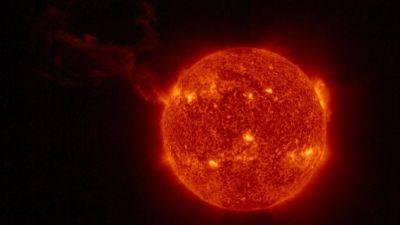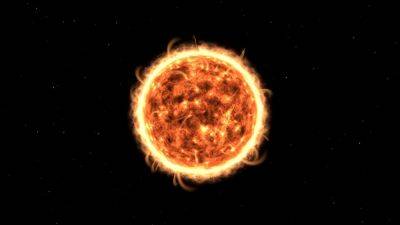There have been many instances of asteroids passing by Earth in the last few weeks. Just yesterday, a 45 feet wide asteroid flew past the planet at a distance of approximately 3 million kilometers. Due to such close calls with asteroids, NASA, ESA, and other space agencies have developed technology to track these space rocks in their orbits, and even deflect them in case a potential impact scenario develops. Using its tech, NASA has now shed light on an asteroid that is expected to pass Earth today, January 23. Know all about this close approach.
NASA's SDO snaps strongest solar flare since 2017, sparking radio blackouts on Earth
03.01.2024 - 12:38 / tech.hindustantimes.com
Slowly and steadily, solar activity has been on the rise after a brief lull. In the last few months, we've witnessed a growing number of solar flares, and solar storms, all of which have been linked to the current solar cycle. For the unaware, the solar cycle is an 11-year period during which the Sun's activity crests and troughs. According to scientists, the solar cycle 25 will enter the peak of solar maximum in mid-2024, and it has already exceeded the predicted number of sunspots. However, the solar activity isn't likely to decrease anytime soon, and a stark reminder of the Sun's might was witnessed on December 31, 2023, as the strongest solar flare since 2017 was recorded by NASA. Check details.
According to NASA, the Solar Dynamics Observatory (SDO) captured the strongest solar flare since 2017 on December 31 at 4:55 p.m. EST. The recorded flare measured X5.0 in intensity. Interestingly, NASA revealed that it originated from the same sunspot that hurled out an X2.8 solar flare on December 14.
This solar flare also caused an “R3 Strong Radio Blackout”, according to the National Oceanic and Atmospheric Administration. It was the strongest solar flare recorded since the X8.2 flare which was captured on September 10, 2017.
X-class solar flares can create radiation storms which have the potential to not only harm the satellites but also give small doses of radiation to the people flying in airplanes at the time! Moreover, these devastating flares can disrupt global communications and bring down the power grids to create blackouts.
If the X-class flares are too strong, they can result in loops that are ten times as big as Earth which leaps off the Sun's surface as the magnetic fields cross over, according to NASA. When these loops reconnect, they can produce as much energy as a billion hydrogen bombs!
The Sun entered solar cycle 25 in 2019 and it is expected that it will hit its peak between 2024-2025. And this is the main reason why the Sun has suddenly become so violent.
A Nobel Prize winner has cautioned against piling into studying science, technology, engineering, and mathematics (STEM) subjects. Says creative skills may thrive in a world dominated by AI . Check here.
You buy a new phone case from an online retailer. The phone case arrives safely at your house, the online retailer makes a small profit and everyone is happy. Know what is going on here.
Cinema or politics, chocolates or perfume... social media influencers cover it all and are set to spread their influence further and wider in 2024. Some interesting details in this article. Check it out here.
One more thing! We are now on WhatsApp Channels! Follow us there so you never miss any updates from the world of technology. To follow the HT Tech

Solar storm danger: Sunspot ‘10 times wider than Earth’ could hurl out M-class solar flares
Earth witnessed f X-class solar flares a number of times in the last few months. For the unaware, X-class solar flares are the most intense flares which can result in long-lasting radiation storms. In December, there were two instances of terrifying X-class solar flares hitting the planet, one of which caused a radio blackout in the polar regions for almost 3 days. Now, another solar storm danger has been highlighted as a massive sunspot on the solar surface could hurl out M-class solar flares towards Earth. Know all about this solar storm danger.

Asteroid 2024 BM to pass Earth by just a whisker today, reveals NASA; Check size, speed, more
As per the details issued by NASA's Center for Near-Earth Object Studies (CNEOS), the asteroid has been designated as Asteroid 2024 BM. This asteroid is expected to pass Earth at a distance of approximately 3 million kilometers today, January 22. It is already travelling towards Earth in its orbit at 21511 kilometers per hour which is almost as fast as Intercontinental Ballistic Missiles (ICBMs)! Is the asteroid dangerous? Check details.

Asteroid 2024 AE3 to pass by Earth today, says NASA! How big is it? Find out
NASA, with the help of its advanced space and ground-based telescopes, has recently tracked the asteroid that is set to pass Earth today, January 19. The asteroid, given the designation of Asteroid 2024 AE3 by NASA's Center for Near-Earth Object Studies (CNEOS), is travelling towards Earth in its orbit at a breakneck speed of 27076 kilometers per hour, which is almost as fast as Intercontinental Ballistic Missiles (ICBMs)!

130-foot asteroid to come as close as 1.5 mn km to Earth; NASA reveals speed, and other details
Did you know that not all asteroids have the same composition? According to NASA, the three primary classifications of asteroids are C-type, S-type, and M-type. C-type asteroids, which are composed primarily of carbon-rich substances, are the most frequent. S-type asteroids, which are made up mainly of silicate minerals, are less common. M-type asteroids, which are primarily composed of metal, are the least prevalent. One asteroid, whose composition is still unknown, is set to pass Earth today, January 18. Know all about this close encounter.

NASA says 160-foot asteroid will pass Earth today; Check speed, distance, and more
In a new development, NASA's Defense Coordination Office (PDCO), responsible for monitoring the skies and watching various Near-Earth Objects (NEOs), has shed light on an asteroid that will pass Earth closely today, January 15. The asteroid was discovered and tracked using NASA's advanced instruments such as the NEOWISE telescope, Atacama Large Millimeter/submillimeter Array (ALMA), Pans-STARRS1, and Catalina Sky Survey. Know all about the asteroid's close approach to Earth such as its speed, size, distance of approach, and more.

Lockheed and NASA Unveil Supersonic Jet X-59 That Curbs Window-Shattering Sonic Boom
Lockheed Martin Corp. and NASA gave the public a sneak peek of a plane that could pave the way for cutting some flight times in half. The X-59, which was unveiled on Friday afternoon in Palmdale, California, has been designed to fly faster than the speed of sound with much less noise. When planes break the sound barrier — called Mach 1 — a loud and continuous sonic boom is created that can shatter windows on the ground. The US banned civilian aircraft from reaching this speed over land in 1973.

NASA says Asteroid 2023 WZ3 will pass Earth today; Know details of this close encounter
While these space rocks are millions or even billions of kilometers away from Earth, located in the main asteroid belt between the orbits of Mars and Jupiter, their orbits bring them close to Earth on some occasions. Spacecraft such as Dawn, OSIRIS-REx, and Hayabusa2 have helped in discovering and studying asteroids, unlocking their secrets. Moreover, NASA has several space telescopes and ground-based observatories in place such as the NEOWISE telescope, Atacama Large Millimeter/submillimeter Array (ALMA), Pans-STARRS1, Catalina Sky Survey, the Hubble Space Telescope and the new $1 billion James Webb Space Telescope.

Solar flare danger! Growing sunspot could spark a solar storm today, reveals NASA
Solar storm today: Solar activity has been on a dangerous rise in the last few months, and we've already seen various solar phenomena impact Earth. In the last month, there were two instances of terrifying X-class solar flares hitting the planet, one of which caused a radio blackout in the polar regions for almost 3 days. The Sun has been showing all its might for the past couple of months and as we approach the solar maximum that will likely occur in 2024-25, its wrath is only expected to increase. NASA has now revealed a growing sunspot that could hurl out a solar flare and spark a solar storm. Check details.

Apollo group asteroid to buzz Earth, says NASA; Check speed, size, and other details
NASA, ESA, and other space agencies have developed technology to track asteroids in their orbits, and even deflect them in case a potential impact scenario develops. While most of them are present in the main asteroid belt located between the orbits of Mars and Jupiter, they often pass Earth. Interaction with a planet's gravitational field can sometimes knock asteroids off course, sending them tumbling towards a planet for impact. Therefore, it is crucial that asteroids be tracked to minimize the uncertainties around their close approaches. Using its tech, NASA has now shed light on an asteroid that is expected to pass Earth today, January 10. Know all about this close approach.

Two asteroids set to pass Earth today, reveals NASA; Check speed, size, and other details
When NASA's telescopes track a new Near-Earth Asteroid (NEA), astronomers measure the asteroid's observed positions in the sky and report them to the Minor Planet Center. The Center for Near-Earth Object Studies (CNEOS) then uses that data to determine the asteroid's most likely orbit around the Sun, according to NASA. 2024 has begun multiple asteroid approaches in the first two days, and the trend is set to continue today. Not one, but two asteroids are expected to fly past Earth at close quarters today, January 9. Check details.

Solar storm warning: Unstable sunspots could hurl out X-class solar flares today, NASA says
Even though we're just 4 days into 2024, we've seen already seen several strong solar flares hurled out towards Earth, sparking a solar storm. On December 31, the Sun hurled out an X-class solar flare that hit Earth just a few days ago, and it is still causing radio blackouts in the polar regions. The Sun has been showing all its might for the past couple of months and as we approach the solar maximum that will likely occur in 2024-25, its wrath is only expected to increase. NASA has revealed that the effects of this rising solar activity are now being seen again as multiple sunspots possess energy for solar flares that can spark a solar storm. Know all about this upcoming solar storm today.
